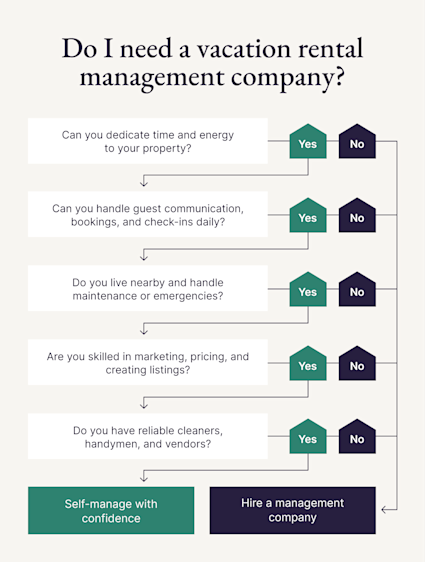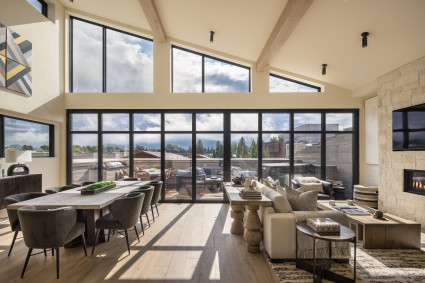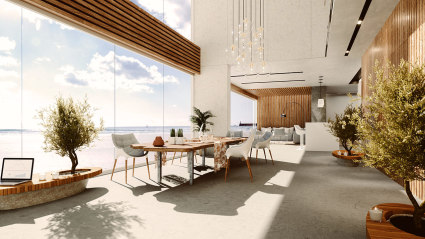| Company | Reviews (Trustpilot) | Cost | Features |
|---|---|---|---|
| Vacasa | ⭐⭐⭐⭐ (4.3) | Around 30% of booking price | Full-service, local management teams |
| Evolve | ⭐⭐⭐⭐ (3.8) | Starting at 10% of booking price | Risk-free guarantee, owner flexibility |
| AvantStay | ⭐⭐⭐⭐⭐ (4.7) | Varies, includes booking fee + nightly rates | Large homes designed for groups, luxury experiences |
| SkyRun | ⭐⭐⭐ (3.2) | Dynamic pricing model | No onboarding fees, smart home tech |
| Casago | No Trustpilot reviews | 20% to 30% of booking price | Includes marketing, tax services and monthly inspections |
| Awning | ⭐⭐ (2.3) | Starting at 10% of booking price | Hands-on service, from buying to managing the property |
| Pacaso | ⭐⭐⭐⭐⭐ (4.8) | Co-ownership-based model | Curated portfolio, share the property management costs with co-owners |
1. Vacasa
Vacasa offers full-service vacation rental management, focused on “drive-to” vacation destinations across the United States. They have about 40,000 vacation homes in places like San Diego, Miami, the Florida Keys, Park City, Lake Tahoe and Cape Cod. You’ll also find Vacasa-managed properties in Belize, Canada, Costa Rica and Mexico. Even though they’re currently merging with Casago, Vacasa is still operating as usual. The company focuses on whole-family rentals, including single-family homes, condominiums and townhomes. The hallmark of its offerings is 24/7 customer service for renters via phone or app and local management teams in case issues arise. For property owners, Vacasa’s sales and marketing services are a big draw. It provides 3D virtual home tours, professional photography and data-driven, dynamic pricing technology.| Pros | Cons |
|---|---|
| Generally good reviews | Higher fees |
| Convenient locations | Mixed reviews on customer service response times |
| Professional marketing | Mixed reviews on issues with amenities |
| Local property care teams |
Pricing and fees
Vacasa’s vacation property management includes a full-service deal, including bookkeeping, marketing and 24/7 guest support. However, pricing varies depending on the needs of the property and the local market.| Plans/Service | Cost | Features |
| Full service | Around 30% per booking + additional fees | Full-service management |
2. Evolve
Since launching in 2011, Evolve has hosted over 16 million guests and served more than 30,000 owners in vacation rentals across North America. Homes represented by Evolve can be booked directly on the Evolve website, but they’re also showcased on sites like Airbnb and Vrbo. Evolve boasts a lower-than-average property management fee, starting at 10%. It comes paired with a “risk-free guarantee,” which says they only charge their management fee once bookings are secured. Like Vacasa, Evolve offers dynamic pricing and top-notch marketing. They also don’t limit personal stays, so you can enjoy your home as much as you want. Evolve has listings in destinations from California to New England, the Southwest to mountain getaways with ski resorts and plenty of beach towns.| Pros | Cons |
|---|---|
| Great booking experience per reviews | Mixed reviews on last-minute cancellations |
| Lower fees | Less hands-on than other providers |
Pricing and fees
As far as vacation rental management companies go, Evolve is one of the most affordable. However, they don’t include some basic services like cleaning or maintenance.| Plans/Service | Cost | Features |
| Core management | Starting at 10% of the booking cost | Listing, marketing, pricing, booking support |
| Plus management | Starting at 15% of the booking cost | Core features + premium support, increased listing exposure and enhanced risk protection |
3. AvantStay
If your property is on the larger side, you’ll want to take a look at AvantStay. They specialize in vacation rentals for larger homes — from three to 10 bedrooms, specifically. Their portfolio boasts unique properties like sprawling ranches, coastal homes, mountain retreats, picture-perfect villas and lakeside cabins. They represent homes in trendy locations like Asheville, Austin, the Coachella Valley, Sonoma, and Vail. Their rentals are popular with large families and groups of friends, as well as corporate retreat-goers. AvantStay appeals to property owners with specific investment and financial goals and those who want top-notch service. Owners enjoy the services of a dedicated account manager, flexible contracts and included liability coverage. Perhaps the most appealing perk may be the Vacation Club membership, where property owners earn travel credits that can be redeemed for stays at other AvantStay properties.| Pros | Cons |
|---|---|
| Great locations | Higher-end pricing |
| Excellent maintenance | Focused on larger homes |
| Responsive support team | Homeowner portal |
| Dedicated account management |
Pricing and fees
As one of the top management rental companies, AvantStay prices and fees mirror their upscale services. You’d need a quote for their package.| Plans/Service | Cost | Features |
| Full service | Varies depending on location, season and property type | Damage protection, proactive maintenance, revenue management |
4. SkyRun
A collective of independent vacation rental companies, SkyRun offers the technology services and management expertise of a large property management company paired with staff on the ground in your destination, ensuring everything is running smoothly. SkyRun offers second-home owners two key differentiators. First, their preventative maintenance program uses regular inspections and smart home technology to ensure your home is in good working order for every guest. Second, they don’t charge new owners any onboarding fees.| Pros | Cons |
|---|---|
| No onboarding fees | Service levels vary by location |
| Preventative maintenance program | Less unified branding |
| Strong local presence | Not many reviews |
Pricing and fees
SkyRun is a collective of property managers and each may have their own pricing. You have to contact a vacation rental manager and get a quote.| Plans/Service | Cost | Features |
| Full service | Varies | Efficient tech, revenue management, 24/7 guest support, maintenance |
5. Casago
Casago is a smaller, Arizona-based property management firm with a combination of resort properties and individual homes in its portfolio. Management services are available in a focused set of locations, mostly Arizona, Southern California and Mexico. However, Casago operates with a franchise model, which means you’ll find Casago-managed homes in many destinations. In fact, they’re currently merging with one of the vacation home rental companies on this list: Vacasa. Their full-service property management includes marketing, filing of local and state sales taxes, utility payments and everything related to renter management, like check-in and check-out, cleaning, maintenance and monthly inspections.| Pros | Cons |
|---|---|
| Local presence in niche markets | No reviews available on Trustpilot |
| Guest service 24/7 | Varies by franchise operator |
| Pre-guest arrival and post-departure inspections |
Pricing and fees
Casago’s vacation home management pricing depends on the size of the property. They use a commission-based structure.| Plans/Service | Cost | Features |
| Full service | 20%-30% of the booking cost | Inspections, tax services, marketing |
6. Awning
Awning provides vacation rental management services with an emphasis on data and automation. The company supports owners with pricing tools, market analysis and property setup. It focuses on prospective owners looking to enter the short-term rental space with an investment mindset.Its services include: guest communication, dynamic pricing and coordination of cleaning and maintenance. Availability and level of service can vary by market, and the platform is best suited for owners seeking a more analytical and structured management approach.| Pros | Cons |
|---|---|
| Real-time data dashboards | Less focused on hospitality |
| Personalized investment guidance | Mixed to poor guest ratings |
Pricing and fees
When it comes to vacation home property management, Awning has a distinct payment structure. They optimize their pricing according to various factors, such as the size and location of the property, to maximize returns.| Plans/Service | Cost | Features |
| Full service | Starting at 10% | Property maintenance, guest support, marketing |
7. Pacaso
Pacaso offers a different path for second home co-ownership: one that prioritizes lifestyle and long-term value without the responsibilities of renting. Instead of listing your home on vacation rental platforms, Pacaso allows you to co-own a fully managed, luxury vacation home with a small group of vetted buyers. Each owner holds a real estate interest, unlocking equity potential while enjoying time in the home throughout the year.All maintenance, cleaning and management are handled by Pacaso, so there’s no need to chase rent payments or coordinate guest stays. This makes it the best vacation property management company for those who want the benefits of second home co-ownership without the responsibilities of hosting.| Pros | Cons |
|---|---|
| Build real equity | No renting |
| Full-service professionally managed | |
| Highest Trustpilot rating |
Pricing and fees
Pacaso’s home property management costs depend on various factors, particularly your share of the property. Pacaso budgets for the year, estimating your monthly costs.| Plans/Service | Cost | Features |
| Full service | Co-ownership-based | Taxes and insurance, estimated utility costs, preventive maintenance, property management |

Pros and cons of using a property management company
Hiring a property management company can be a smart move for vacation or second home owners who don’t live nearby or don’t want to manage day-to-day tasks. These companies take over responsibilities, such as guest communication, maintenance, cleaning and marketing. However, that convenience may be costly. Here’s a list of advantages and disadvantages to consider:| Pros | Cons |
|---|---|
| No need to manage guests or repairs | Service quality may vary by provider or location |
| Local teams handle issues | Costs vary depending on the property management company |
| Compliance with local laws and tax filing | Some companies limit owner use or require long contracts |
Pros of using a property management company
Undoubtedly, the biggest advantage of using a property management company is knowing that your property is in good hands and renters are being taken care of. You pay for peace of mind. Also, you may get:- Quick response time to owner or renter issues
- Marketing and listing promotions
- Return optimization
- Day-to-day maintenance
Cons of using a property management company
The biggest owner gripe you’re likely to have about vacation home property management companies is the cost. Here are a few things to keep in mind:- Management fees may vary from 10% to 35%
- You may need to add extra services if your company doesn’t offer them
- Initial setup fees may apply
- Less control over bookings or stays
How to choose the right vacation home management company
As you compare and contrast management companies, it can seem like they’re all offering the same core set of services. Here are a few things to consider when narrowing down your choices:- Local expertise and presence: Look for a property management company with local representatives available. Not only do they understand the local rental market for pricing purposes, but they’re also nearby in case of a maintenance emergency.
- Contract transparency: Not all property management contracts are the same. Make sure you examine commission fees, costs for services like maintenance and repairs, payment terms and the length of the contract.
- Customer service: Try to get a feel for both the level of service you’ll receive as the owner and the responsiveness they’ll have with renters. Remember to ask to see their guest relations policy.
- What’s included: Make sure it’s clear upfront what’s included in your management fee and what will be billed to you separately. Rental profits are easily eaten up by things like after-hours maintenance, cleaning charges and marketing fees.










